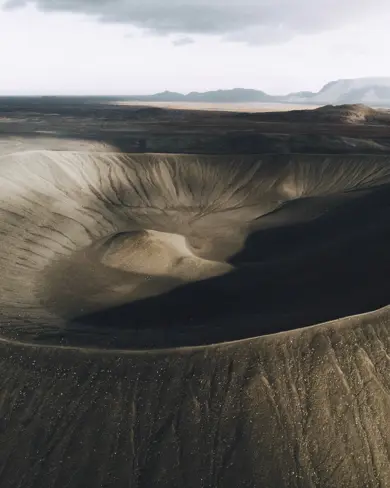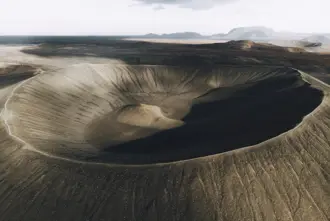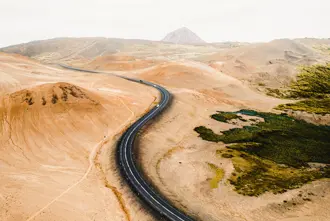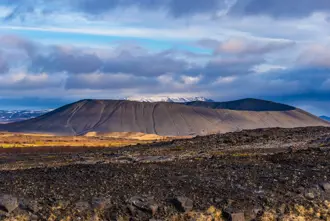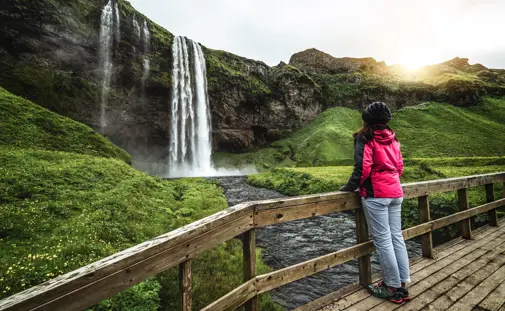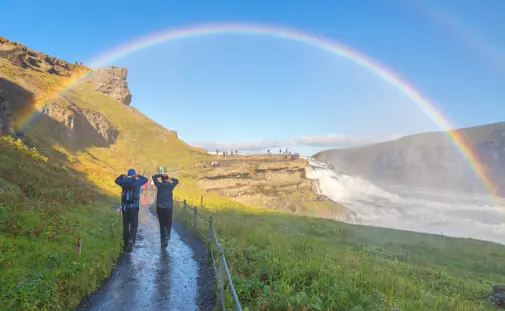Hverfell Volcanic Crater in North Iceland
Hverfjall, also known as Hverfell, is a striking volcanic crater located near Lake Mývatn in northern Iceland. This nearly symmetrical tephra cone is one of the most impressive geological formations in the region, standing about 396 meters (1,300 feet) high and stretching over 1 kilometer (0.6 miles) in diameter. Formed approximately 2,500 years ago during a massive volcanic eruption, Hverfjall is a prime example of Iceland’s dramatic volcanic landscape.
The crater is easily accessible, with a well-marked trail leading to the top, where visitors are rewarded with panoramic views of the surrounding Mývatn area, including other volcanic features, lava fields, and the serene lake. The ascent to the rim is relatively steep but manageable, and the experience of standing on the edge of this vast crater, overlooking the rugged terrain, is truly unforgettable. The interior of Hverfjall, filled with loose tephra, gives the crater a lunar-like appearance, adding to the otherworldly atmosphere of the site.
Crater Facts & Figures
- Elevation: 420 m (1,378 ft)
- Diameter of crater: ca 1 kilometer (0.6 miles)
- Age: It was estimated to be produced circa 2,500 years ago due to a volcanic eruption
- Type: Tuff ring volcano
- Last Eruption: 2,500 BP
- Game of Thrones: Visible in several scenes, shot for the popular series included among locations in the area of Mývatn.
Why is Hverfjall formed this way?
Hverfjall is formed near-circular in shape as a result of an explosive volcanic eruption which caused ash, pumice, and lava fragments to blast out from the center, creating a tuff ring crater.
What do you see from the top of Hverfjall?
From the top of Hverfjall, you’ll view the panorama of the Mývatn area: volcanic scenery, fields of lava, and especially the wide lake of Mývatn. On a clear day, you’ll see nearby volcanic formations such as Dimmuborgir and vast lava fields.
Is Hverfjall active?
No, Hverfjall is not active. The last time it erupted was approximately 2,500 years ago, and nowadays it is considered a dormant volcano.
Where is Hverfjall located?
It’s located in North Iceland, pretty close to Lake Mývatn, an area very famous for its geothermal activity and volcanic landscapes. Hverfjall Crater lies about 5 km from the village of Reykjahlíð and thus is accessible to visitors in the area.
- Location coordinates: 65°36'18.5"N 16°52'25.3"W
How to Reach Hverfjall?
To get to Hverfjall, drive from anywhere in the country through Route 1 to the district of Mývatn in North Iceland. From Reykjavik, that will be approximately 475 kilometers, taking roughly 6 hours. Once you arrive at the Mývatn district, look around for signs showing the way to Hverfjall and other nearby attractions.
Hverfjall Volcano Trail
One of the best ways to see Hverfjall at close quarters is to hike around it. The Hverfjall Volcano Trail leads up to the top of the crater and offers great, wide views over surrounding areas. Though relatively short, the trail leading up the mountain is steep, thus moderately challenging.
- Difficulty: Moderate (due to steep ascent)
- Distance: 3 kilometers (1.9 miles) return
- Elevation Gain: 200 meters (656 feet)
- Duration: About 30-45 minutes to the top, looking at 1-1.5 hours round trip
- Season: Can be done any time of year, but in winter expect icy and windy conditions. Proper footwear and gear is advised
From the top, hikers can walk around the rim and get stunning views over Lake Mývatn, the volcanic system Krafla, and the lava fields below. Make sure to be prepared for strong winds at the top, and protect the fragile landscape by sticking to marked paths.
Accommodation near Hverfjall
From hotels and guest houses to campsites, a range of accommodation dot the region surrounding Hverfjall and Mývatn area. All within driving distance from the main attractions. The more modern Hotel Mývatn by Berjaya (with a number of spacious rooms equipped with views over the surrounding nature) also offers great room rates. A good option for the budget-conscious is Vogar Travel Service which sits about 10 km south of Lake Mývatn. This guesthouse and campground offers a budget-friendly place to stay in an idyllic location. Finally, the Dimmuborgir Guesthouse is close to the Dimmuborgir Lava Fields and has simple furnished rooms as well as easy access to various sights nearby – a great choice for those looking to discover more of the area.
Restaurants near Hverfjall
Around Hverfjall you have some great dining options especially if you're looking to try traditional Icelandic meals. Vogafjós Farm Resort, next to the cowhouse where some of their cows are during the summer months and with a window for you to look at them while eating, is unique and really adds to your authentic dining experience. For something a bit more homey, grab some steamed Icelandic lamb, or fresh fish at Gamli Bærinn in Reykjahlíð. For something a bit lighter, head to café Kvika by the Mývatn Nature Baths for a cozy snack or coffee after some relaxation.
Local Attractions worth seeing
Hverfjall is just one out of the many impressive attractions that this area has to offer. Other nearby spots that should not be missed include Dimmuborgir Lava Fields, eerie lava shapes in different ‘dramatic’ forms. There are numerous walking tracks around this mythical region thus it is an interesting place to explore. Unwind in a geothermal spa — known as the "Blue Lagoon of the North" — Mývatn Nature Baths after a hike. The Grjótagjá Cave—a small lava cave with a geothermal spring—gained international fame being featured on Game of Thrones. Though it cannot be entered due to changing temperatures, you can have a look through the gates. The Krafla Volcano is also located about 30 minutes from Hverfjall and has some great hiking opportunities around geothermal vents and lava fields, taking your visit to the next level.
Hverfjall Parking
At the foot of Hverfjall, there is a great big parking lot, only a very short walk away from the hiking trail that leads up to the crater. The car park charges a fee. From the parking lot, it takes only 5-10 minutes to walk to the trailhead that begins the stiff ascent up to the top of the crater.
